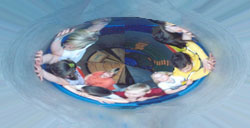Harriet G. Williams1, Lindsey Ashley2 and Gerhild Ullmann1
1University of South Carolina,
2University of North Carolina
Abstract
In this case study, two male children (ages 6 and 7) with and without developmental coordination disorder (DCD) walked across a GaitRITE pathway under four „walk‟ conditions (two single and two dual task conditions; simple and complex); gait variables studied included speed, cadence, step and stride length. Both groups exhibited consistent right-left symmetry in step and stride length across all „walks‟. Typical children adapted to walk conditions by holding stride length constant and varying step length; children with DCD linked stride-step length and modified them in parallel. In contrast to other studies, typical children were more variable in step-stride length than DCD children. Children with DCD linked modification of gait speed and cadence to single vs dual walk conditions; typically developing children modified speed and cadence with each change in “walk” condition. Overall children with DCD walked slower, took fewer steps with shorter strides and steps than typical children. Possible explanations for differences in gait characteristics and underlying motor system processes are discussed.
Keywords:
Children, Developmental Coordination Disorder, Gait
Download (pdf, 225kb)






